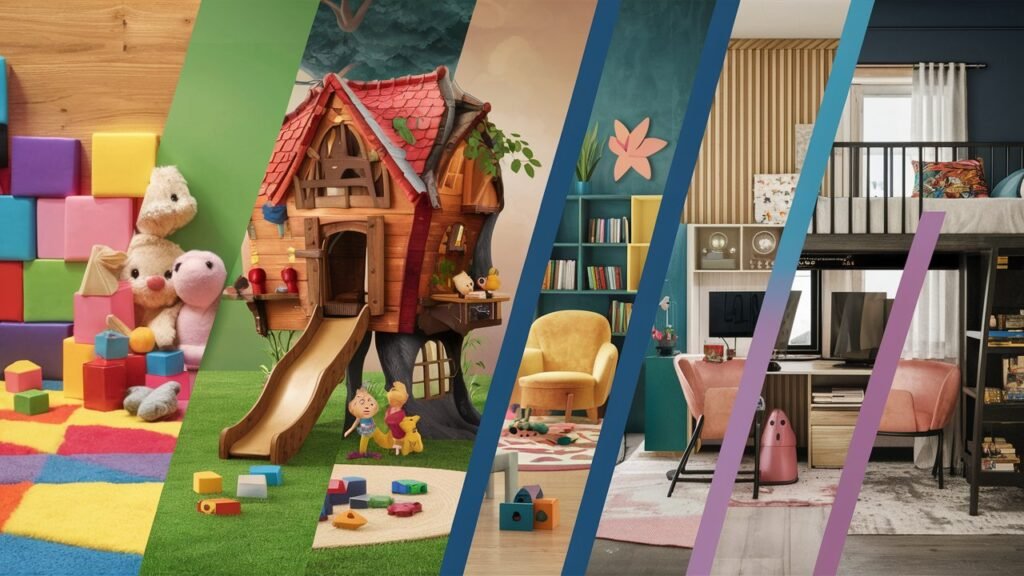Play is a very serious business, at least according to the United Nations, which has recognized play as the right of every child. Likewise, in a landmark report, The American Academy of Pediatrics deemed play ” essential to development because it contributes to children and youth’s cognitive, physical, social, and emotional well-being. “
While children can find a way to play almost anywhere (whether you want them to or not!), creating a designated play area can be an invaluable addition to any home. A play area provides a safe and nurturing environment that can support your children’s development; it encourages unstructured exploration and imagination, enticing kids to take risks, problem-solve, and discover new talents and interests at their own pace.
The key to getting the most out of your play area is to curate a space that can grow and adapt as your children develop. In this article, we’ll explore how to intentionally update your play area for every stage of life, from toddler to tween.
Creating a Play Area in Your Home
The first step to building a play area for your children is to designate an appropriate space in your home where all the fun and imagination can begin. A spare bedroom or an empty basement can make for an excellent play area. However, not every house is brimming with free space, especially if you have two or three kids.
But that’s not a problem: You can create play areas by maximizing nooks, corners, or open areas in shared living spaces. By sectioning off the space creatively, you can make a play area feel like a realm all its own. For example, use colorful floor mats, low bookshelves, baby gates, or kid-friendly dividers to define the play zone. With some thoughtful space planning, you can integrate a play area almost anywhere in the home.
Now that you have some ideas for where to put your play area, let’s examine how to design the space to engage children of any age.
Play Areas for Toddlers (Ages 1 to 3)
The rapid development of motor skills and language happens during the toddler years; toddlers want to pick up and explore everything. When building a play area, add items that support pretend play, problem-solving, motor skills, and vocabulary enhancement.
- Bring in child-sized furniture such as a small table and chairs.
- Include age-appropriate arts, crafts, and puzzles to develop fine motor skills.
- Dedicate open floor space to push/pull toys and riding toys for overall motor skill development.
- Add toys that encourage imagination, like a play kitchen or a dress-up trunk.
- Rotate toys regularly to keep your kids interested.
Play Areas for Preschoolers (Ages 3 to 5)
Preschoolers are bursting with creativity. They have a million questions and love diving full-tilt into imaginary worlds. Adapt your play area to support fine motor skills, dexterity, and more advanced vocabulary. Give your children the toys and supplies they need to go on exciting imaginary adventures, and use play to teach important skills like self-regulation.
- Created designated zones for different activities such as art, building, and dramatic play.
- Provide crafting supplies and puzzles.
- Include interactive technology toys, but limit screen time.
- Add a fort-building area with blankets, pillows, and cardboard boxes.
- Update books to share important lessons, such as the value of sharing.
Play Areas for Young Children (Ages 6 to 8)
Early school-age children are developing more nuanced reasoning capabilities. They can handle more rules and structure in their play. Redesign the play area with toys and supplies that can sharpen strategic thinking, patience, and attention span. Friendships become increasingly important, so make sure the play area can accommodate groups.
- Incorporate desks/workspaces for crafting, building, and writing activities.
- Set up active play areas with balls, hula hoops, and indoor climbers to enhance coordination and strength.
- Support growing interests in art, music, building, and science experiments.
- Make space for longer-term projects that kids can personalize.
- Provide age-appropriate board games, card games, building sets, and strategy toys.
- Create the expectation that your children will regularly clean the space after playtime to foster organizational skills.
Play Areas for Tweens (Ages 9 to 12)
Your tween’s unique personality is in full force, and they are rapidly developing unique interests and hobbies. At this point, invite them to help plan and update the play area. In fact, you may not even want to call it a “play area” anymore. Design this new “hobby space” to help your children hone their interests. Friendships are everything at this age, so expect your tween to invite their buddies over for group hangs.
- Let your tween take the lead in redesigning the space. How do they want to use it?
- Add comfy lounging furniture for your kids and their friends.
- Include the items your tween needs to pursue their favorite hobbies, such as musical instruments, electronics, art supplies, and building materials.
- Create study zones for reading, learning, and homework.
- Encourage long-term projects like building robots, making videos, or composing songs.
Create a Space for Play
Play areas may seem like a luxury, but they can be at the heart of your child’s development into a well-adjusted adult. They allow your child to explore, develop new abilities, learn important social skills, and pursue interests that they can take into adulthood. No matter the size or layout of your household, all it takes is a little creativity and intentional design to carve out a play area.
Thoughtfully adapt the play area to meet your child’s changing needs. From toddler zones filled with imagination-fueling toys to preteen spaces designed to promote independence and facilitate hobbies, your play area should grow with your child. With simple adjustments over time, this invaluable space can continue to inspire your child’s curiosity, learning, and joy through the power of play.

